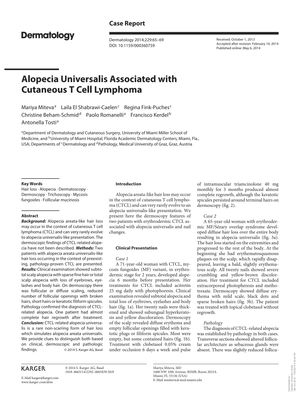Alopecia Universalis Associated with Cutaneous T Cell Lymphoma
January 2014
in “
Dermatology
”
alopecia universalis cutaneous T cell lymphoma CTCL mycosis fungoides clobetasol triamcinolone erythrodermic MF/Sézary overlap syndrome dermoscopic examination follicular scaling diffuse scaling follicular openings keratotic filiform spicules altered follicular architecture miniaturized follicles lichenoid/interface lymphoid epidermotropic CD4 T cell infiltrate alopecia areata universalis MF Sézary syndrome dermoscopy scaling spicules follicular architecture CD4 T cell infiltrate

TLDR Some patients with a type of skin lymphoma can experience a rare, non-scarring hair loss that looks like another hair loss condition but has distinct features.
The document reports on two patients with alopecia universalis-like hair loss associated with cutaneous T cell lymphoma (CTCL). The first patient, a 71-year-old woman with the mycosis fungoides (MF) variant of CTCL, experienced almost complete hair regrowth after treatment with clobetasol and triamcinolone. The second patient, a 65-year-old woman with erythrodermic MF/Sézary overlap syndrome, did not have hair regrowth after treatment with topical clobetasol. Dermoscopic examination showed similar features in both cases, including follicular or diffuse scaling, a reduced number of follicular openings, and keratotic filiform spicules. Pathological examination confirmed CTCL-related alopecia, with findings such as altered follicular architecture, miniaturized follicles, and a lichenoid/interface lymphoid epidermotropic CD4 T cell infiltrate. The study concludes that CTCL-related alopecia universalis is a rare, non-scarring form of hair loss that can be mistaken for alopecia areata universalis, and it highlights clinical, dermoscopic, and pathological features that can help differentiate between the two conditions.


